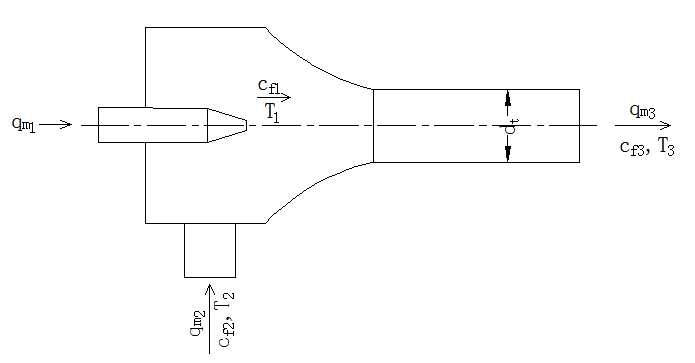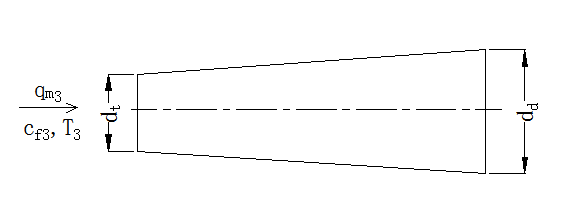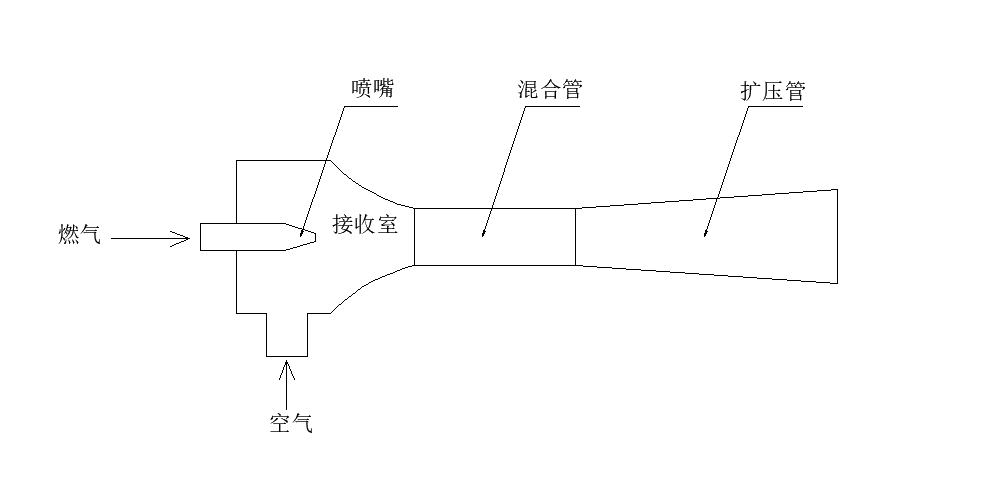5.4kW大气式燃气灶引射器性能分析毕业论文
2020-06-19 21:53:16
摘 要
我国是一个能源消耗大国,由于我国的人口众多,加上目前天然气灶的使用十分的广泛,因此天然气灶消耗的能源的是不容忽视的。现如今,城镇居民的燃气灶的使用量十分之大,这也带来了一系列的问题,如:引射器的配风是否合理,如何提高引射器的燃烧效率,如何减少引射器中天然气燃烧后的氮氧化合物的排放,这不仅是为了响应国家“节能减排”的政策的号召,也是一个国家科技创新的体现。因此,分析影响大气式引射器的燃烧性能的因素是十分有必要的。
本课题对大气式燃气引射器进行了优化,在设计过程中,根据题目要求,确定了5.4kW大气式燃气引射器的最优尺寸,并分析影响引射器引射性能的因素。
具体设计思路如下:首先由给定的引射器的功率确定引射器的燃气量,并计算求得所需要的空气量,进行燃烧分析。再通过改变空气系数,根据能量守恒、质量守恒和动量守恒方程并结合理想气体状态方程,通过建立excel程序建立各个结构尺寸变化对引射器引射性能和工质参数的影响的理论模型。在此截面比下吸入室、混合管、扩压管的尺寸,包括各管的直径、管长、进出口截面的截面积等。在确定最优尺寸的基础之上,通过改变环境温度的大小(温度变化值依据四季的室温环境温度来确定,依次为0℃、15℃、20℃、30℃),运用扩压管出口压力的范围,分析空气系数是如何随环境温度的变化而变化的。接着,在最优结构尺寸下,改变负荷的大小,同时也适当地改变进口燃气的压力,同样运用扩压管出口压力范围为条件,分析随着负荷的改变,空气系数的变化趋势。
结果表明:(1)在其他条件不变时,空气系数在规定的范围变化时(0.35~0.65),由于受扩压管出口压力(一般为1~3Pa)条件约束,本课题中空气系数α=0.65,截面比K=60时得到最优尺寸;(2)在最优尺寸下,若只改变环境温度,空气系数会随环境温度的增加而增大,而且变化的幅度很小,趋于平稳,这意味着该尺寸下的燃烧器,具有较好的稳定性;(3)在最优尺寸下,若改变负荷,并且燃气的进口压力在合理的变化范围下时,空气系数随负荷的减小而增大,且变化幅度几乎趋于一条平行线,这说明该引射器具有较好的稳定性和较强的变负荷适应性。
关键词:天然气 引射器 理论计算 结构设计 性能分析
Performance analysis of 5.4kW atmospheric gas ejector
Abstract
China is a big country with energy consumption. Because of the large population and the wide use of natural gas stoves, the energy consumed by natural gas stoves can not be ignored. Now, the amount of use of gas stoves for urban residents is very large, it also brings a series of problems, such as: air ejector is reasonable, how to improve the combustion efficiency of the ejector, how to reduce nitrogen oxides from natural gas ejector in post combustion emissions, which not only in response to the national "energy conservation" policy call, is also a manifestation of the national scientific and technological innovation. Therefore, it is necessary to analyze the factors that affect the combustion performance of the atmospheric ejector.
The issue of atmospheric gas ejector was optimized in the design process, according to the topic request, to determine the optimal size of 5.4kW atmospheric gas ejector, and analyzes factors influencing the ejectors performance.
The specific design ideas are as follows: firstly, the fuel gas quantity of the ejector is determined by the power of the given ejector, and the required air quantity is calculated to carry out the combustion analysis. By changing the air coefficient, according to energy conservation, momentum conservation and mass conservation equation and the state equation of ideal gas, through the establishment of EXCEL program to establish the theoretical model of each structure size change effect of ejectors and performance parameters of the working medium. In this section, room size ratio suction mixing tube and diffuser, including the tube diameter, tube length, cross sectional area of import and export. Based on the optimal size, by changing the value of the ambient temperature (the temperature changed according to the ambient temperature at room temperature to determine the four seasons, followed by 0 C and 15 C, 20 C and 30 C), the scope of application of pressure pipe outlet pressure air diffuser, analysis of how the coefficients with the ambient temperature change. Then, the optimal structure size, change the size of load, but also appropriate to change the inlet gas pressure, using the same diffuser outlet pressure range of conditions, analysis with the load change, the change trend of air coefficient.
The conclusion shows that: (1) when other conditions remain unchanged, the air coefficient in the specified range change (0.35~0.65), due to the diffuser outlet pressure (1~3Pa) conditions, air coefficient =0.65 in this research, the optimal size of cross section is K=60; (2) in the optimal size. If only change the environment temperature, air coefficient increases when the temperature increases, and the amplitude of variation is small, stable, which means that the size of the burner, has good stability; (3) the optimal size, if the change of load, and the gas inlet pressure in reasonable range when the air coefficient increases with the decrease of load, and the amplitude of variation tends to be almost a parallel line, indicating that the ejector has good stability and strong adaptability to variable load.
Key words: Natural gas; Ejector; Theoretical calculation; Structural design; Performance analysis
目 录
摘 要 I
Abstract II
第一章 绪论 1
1.1研究背景 1
1.2引射器状况 2
1.21引射器的结构及工作原理 2
1.22引射器的分类 2
1.23性能要求 2
1.3国内外研究现状 3
1.31国内研究状况 3
1.32国外研究状况 4
1.4小结 5
第二章 理论计算 6
2.1理论分析 6
2.1.1燃料的选取 6
2.1.2燃烧计算 7
2.2引射器理论计算方法 8
2.2.1喷嘴 8
2.2.2 吸入室 8
2.2.3 混合管 10
2.2.4 扩压管 11
2.3大气式引射器结构 12
2.31工作过程及原理 12
2.3.2设计参数 12
2.4引射器设计 13
2.4.1引射器设计计算流程 14
2.42结构计算 17
2.5本章小结 18
第三章 大气式燃气灶引射器性能分析 19
3.1性能参数分析 19
3.2变空气系数 19
3.3变环境温度 23
3.4变负荷 24
3.5本章小结 26
第四章 总结与展望 27
4.1总结 27
4.2展望 27
参考文献 28
致 谢 30
第一章 绪论
1.1研究背景
当今世界的能源消费主要包括煤炭、石油、天然气,但其存在着储量一定,不可持续的特点。随着工业时代的来临,以及大量机械设备的使用,能源的使用越来越多,能源消耗量也越来越大,因此,如何有效提高能源利用率,如何提高机械设备的效率,降低能源的消耗已然成为当今技术发展的时代主题。在天然气的使用发面,天然气灶首屈一指。现如今未响应国家节能减排的号召,从前的烧草、烧柴早已不复存在,每年的全球居民生活的天然气使用量是十分巨大的。天然气的主要成分是甲烷,相比较传统的草、柴而言,天然气具有燃烧充分、热转化率高、燃烧产生的氮氧化物远低于国家的排放标准、价格低廉、储量也较为丰富。据目前的天然气在城镇居民中的使用现状,设计出一个高效的、最优结构尺寸的燃气引射器就显得尤为重要。
近年来,我国的能源消费在逐年增长,预计至2040年,我国一次能源人均消费量折合标准煤量约为2710t[1],并且人均能源消费量刚达到目前世界人均能源消费量的平均水平。我国的天然气分布十分广泛,其中包括新疆、四川等地区,而新疆地区尤为突出,目前为止共发现8个气田,8个煤层气田。据我国最新的资源评价成果,我国的天然气总资源为 ,其中路上天然气资源占82.1%,海上资源占17.9%[2]。
,其中路上天然气资源占82.1%,海上资源占17.9%[2]。
相关图片展示:











